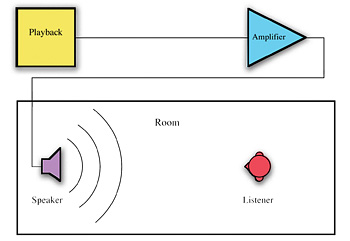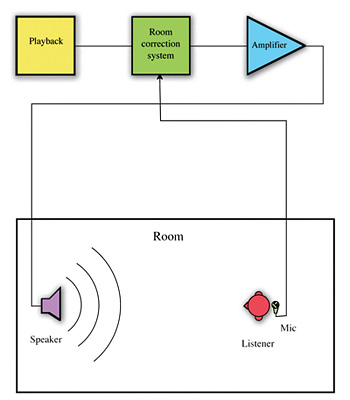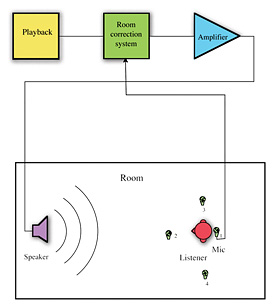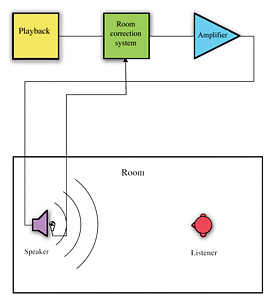Working Together—Small Rooms, Small Loudspeakers
For the past several months I've been reviewing the problems inherent to the reproduction of bass (low frequencies below, say, 200 Hz.) by smallish loudspeakers (less than, oh, 2 feet x 2 feet x 1 foot volume) in small rooms (less than, about, 40 feet x 30 feet x 10 feet). Particularly in control rooms.
The wavelengths of those low frequencies (between about 6 feet and 60 feet) are difficult for loudspeakers this small to reproduce, and in our "small" rooms the folding back (reflecting) of those waves into the room while still propagating causes interactions with themselves that vary as a function of room dimension and the listener's position in the room.
These lead to frequency response problems that change with position. Nasty. Frustrating. Hard to work with.
As I described in my Oct. 5 column ("Helping Control Rooms Handle Low Frequencies"), we can design control rooms to solve these problems by using wall surfaces that mostly absorb low frequencies or, for some applications, wall surfaces that reflect low frequencies. This architectural type of approach can work quite well. However, it is expensive and time-consuming to implement.

Fig. 1: Typical audio playback (one channel shown) In an effort to eliminate or reduce those physical room treatment costs, loudspeaker manufacturers and some of their vendors have devised electronic systems that provide what we call "room correction." Such packages of electronics (usually digital, and always including a microphone) are added to the loudspeaker electronic and acoustic signal paths and are used to "fix" the errors that occur because of the presence of that pesky room in that signal path. We'll take a quick look at the ways room correction is approached, skipping the software details.
Take a look at Fig. 1. In this graphic, an audio playback device sends a signal to a power amplifier, which in turn sends a signal to a loudspeaker in a room with a listener. It is a one-way system, with signal flowing from the playback device to the listener.
ROOM CORRECTION FOR A POINT IN SPACE
Now look at Fig. 2. Here, a simple negative feedback loop is derived from a microphone at the listener's position sent back to the electronic signal path. At the room correction system, it is compared to the original signal.
The original signal is then "modified" to correct for the differences between the original and the microphone versions of the signal so the listener now hears a signal that is approximately equivalent (in spectrum over time) to the original signal.
There are many math approaches to doing this, modifying in either the time or frequency domain. We don't have time to discuss these. Sorry.
This works fairly well, but the more accurate the correction is at the listener, the smaller the zone in the room where it works and the more (quite audible) errors are encountered elsewhere in the room. Does it matter? Yes.

Fig. 2: Typical audio playback with a room correction system addedROOM CORRECTION FOR AN AREA IN SPACE
Now take a look at Fig. 3. Here, we take multiple room measurements (usually sequentially, to save on mic costs) in various spots in a "listening zone." We "average" these to come up with a correction that will be approximately suitable throughout the zone, especially at low frequencies.
POWER RESPONSE CORRECTION FOR A SPEAKER IN A ROOM
Finally, here's Fig. 4. In this scheme, we've already measured the loudspeaker in a known reference space. We now measure the difference from the reference room in the actual playback space due to room reflections, and from this, determine the power response (the average of all possible frequency responses in all locations in the room) of the speaker in this position in this room. From that, we derive a generalized room correction. This only works for low frequencies (long wavelengths). Bang & Olufsen uses this technique for their flagship speaker, the BeoLab 5.
MAKING IT ALL WORK TOGETHER
All of these approaches work quite well, if their limitations are understood and accounted for.
In Fig. 2 we really are stuck at a single point in space, with a tolerance of less than a foot. If either the speaker or the listener is moved, the performance degrades substantially, in unpredictable ways. There can be only one listener, as a general rule.

Fig. 3: Typical playback with a more complex room correction system added In Fig. 3, we have averaged the correction for a listening zone. This allows us to have multiple listeners. The correction won't be as precise, and it won't work for really short wavelengths (less than one foot, possibly).
Nonetheless, we will have "corrected" for the room/speaker interactions for this listening zone, providing a more consistent experience for our group of listeners.
In Fig. 4 we have made a "long wavelength" correction for, in theory, anywhere in the room. Note that it is a generalized solution and that it cannot correct for standing waves. Nonetheless, it works well, with the added flexibility of unrestricted listener movement.
WHAT DOES IT ALL MEAN?
These electronic approaches to adapting loudspeakers to control rooms and end-users' rooms are almost always cheaper, faster and simpler than creating an acoustically optimized space. This is particularly true for audio production work, where we may need to work in multiple rooms; where we may not be able to do much acoustical treatment; where time is of the essence; and where we may need to use identical monitors everywhere.
In the best professional practice, of course, we generally try to do some of both kinds of optimization: at high frequencies we do some absorption on the walls and floors, and we try for stereo symmetry in our speaker placement. Then, we may also add correction to get better control of low frequencies, sometimes working toward a "target" response that we have adopted as a standard.

Fig. 4: Typical playback with a power response correction system added All of these things are compromises, of course. Meanwhile, stable, consistent and predictable bass is one of the hardest things to obtain in a monitoring situation. Stable, consistent and predictable bass that travels well to end-users' rooms is even harder. Using room correction can really help with this latter problem.
When we get to stereo and multichannel production work, room correction can really help pull the spectrum into consistency and also get channels to match really well, which is how we generate really effective phantom images in stereo and surround.
Next month we'll discuss monitor controllers, bass management issues, test signals and working with low frequencies on location. Then, we'll wrap this all up with a consideration of that magic sauce called "envelopment."
Thanks for listening.
Dave Moulton is trying to get his home theater to work. All it wants to do is play! You can complain to him about anything at his website, www.moultonlabs.com.
The professional video industry's #1 source for news, trends and product and tech information. Sign up below.

